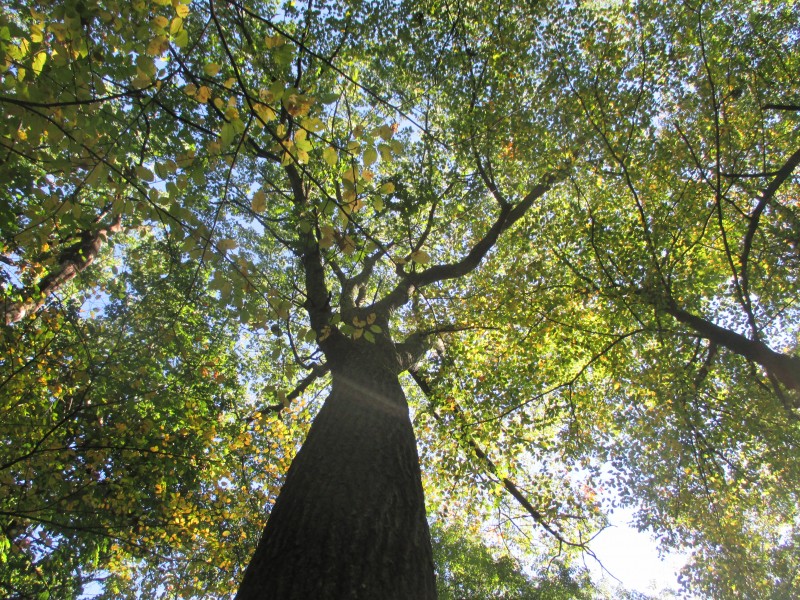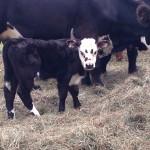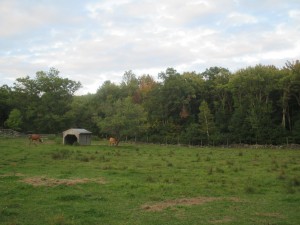HELLO, HARVARD FOREST
My adventure at the Harvard Forest has begun. Last month, I took up residence as a Bullard Fellow in Forest Research at the Harvard Forest, and settled in here for the year to write a book about one tree: a noble old oak, here at the Harvard Forest.

BT QURU 03: The red oak at the center of my book underway here at the Harvard Forest, as autumn just begins to color the black birches in its understory.
At about a century old, it’s a living timeline of human and natural history. In my book, Witness Tree, under contract with Bloomsbury Publishing, I’ll be watching this grand oak through the seasons of the year, and boring deep into its inner workings, and role in the ecology of the forest to tell the story of its human and natural history.
Moving in was hilarious…shipments of at least a dozen apple boxes full of my books and things from home quickly defined me as a Bullard Fellow arriving from Washington State. The fellowship is a generous and precious opportunity to escape the deadlines of my job as a newspaper reporter at the Seattle Times, and stretch out creatively into the research, reporting, and writing of Witness Tree, a book idea I discovered last year while doing field work with the Richardson Lab at Harvard University while a Knight Fellow in Science Journalism at MIT.
I am truly grateful to the KSJ program, Andrew Richardson and the Harvard Forest for this opportunity. I created this blog to share what I learn as I go along – for the Harvard Forest is a wondrous place.
First came the discovery of the lovely, classic New England village of Petersham, MA, incorporated in 1754, and home to about 1,180 people and not an inconsiderable number of cows, chickens, and an uncountable number of trees.
Some of these cows, to my delight, live right outside my door.

One of two baby cows born at the Harvard Forest since I arrived in August and another is on the way!
I live in Community House, owned by Harvard University, and the original farmhouse of John Sanderson, whose farm became some of the original lands incorporated into the Harvard Forest at its founding in 1907.

Cows laze in the pasture by Community House. Built in about 1753, it is home to visiting researchers at the Harvard Forest, including me.
Community House has a venerable history. Once the administrative offices of the forest, with students billeted upstairs, parts of the house date to 1753. Its views to the pasture and woodlot bordered with stone walls that I enjoy now are just the sort of thing Sanderson, one of Petersham’s most prosperous residents, would have seen as he arose on a fine fall morning. Hugh Raup, one of the original directors of the Harvard Forest, wrote a paper on this farm, its history, and what it teaches about changing land use. Published by the Forest History Society, it’s a great read.
These pastures had grown up in forests, following the abandonment of most of the agricultural land in New England beginning in about the 1850s, as the Erie Canal opened agricultural markets in the middle West – with its superior farmland – sparking a soil rush, if you will, of farmers to better prospects.
As people here turned to jobs in the factories and mills that developed in New England, these farmlands went back to woods. The pastoral view I enjoy was deliberately recreated in the 1990s by the Harvard Forest as a historic landscape, recapturing the look of part of the original farmstead at the core of the Harvard Forest, today encompassing nearly 4,000 acres in Central Massachusetts.

The view out my back door at Community House. The cows don’t seem to use their sweet little shed very much, even in the rain.
A department of Harvard University, the forest is an outdoor laboratory, with experiments underway in everything from what happens to ant populations when soils are warmed (to simulate conditions of global warming) to the longest-term record anywhere of the rate of carbon sequestration in the forest, measured from the breath of the trees.
And so, with geranium cuttings mailed from home by my husband Doug MacDonald, plenty of sweaters and an endless curiosity to learn what this forest can teach, I’ve moved in, and started this blog to share my journey.

Geranium cuttings sent from home in Seattle, just planted and making a brave go of it in the window at my office at Shaler Hall, the headquarters of the Harvard Forest.
Look for posts in the Witness Tree blog, cross posted on the Harvard Forest homepage, as my adventure unfolds. See my book in the making, come along for my field work, and wonder, as I know I will, at all that nature can teach.

Leave a Reply